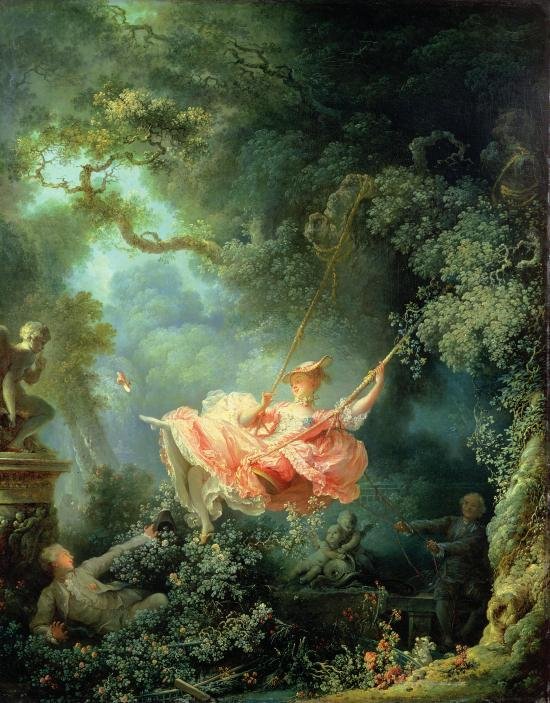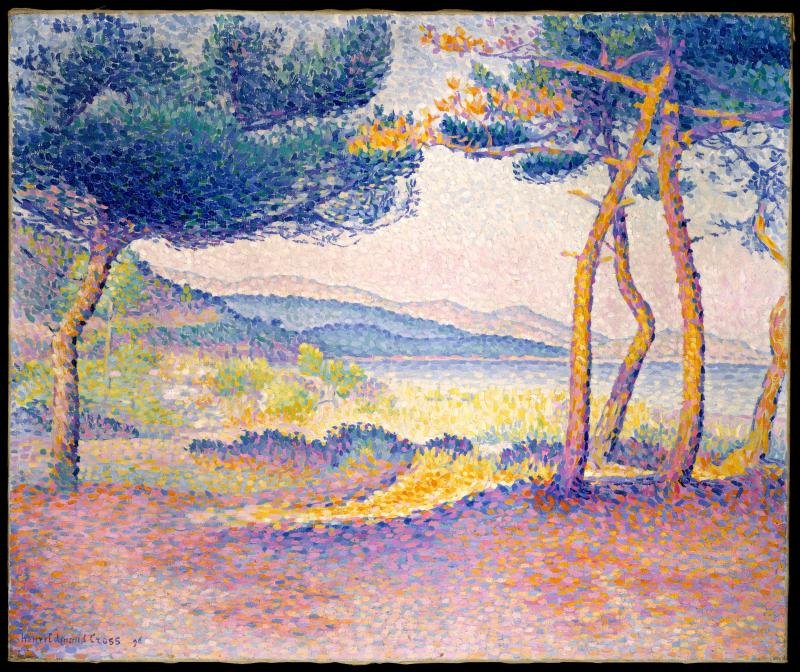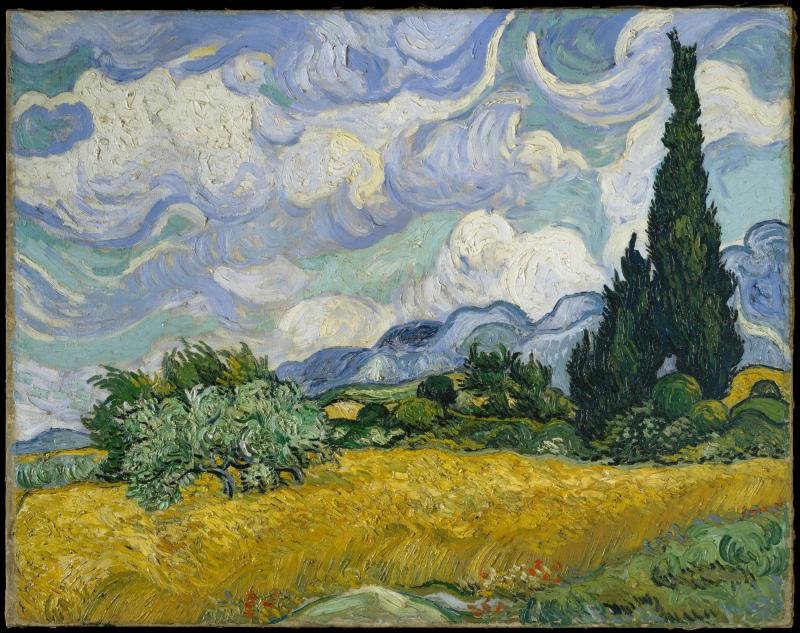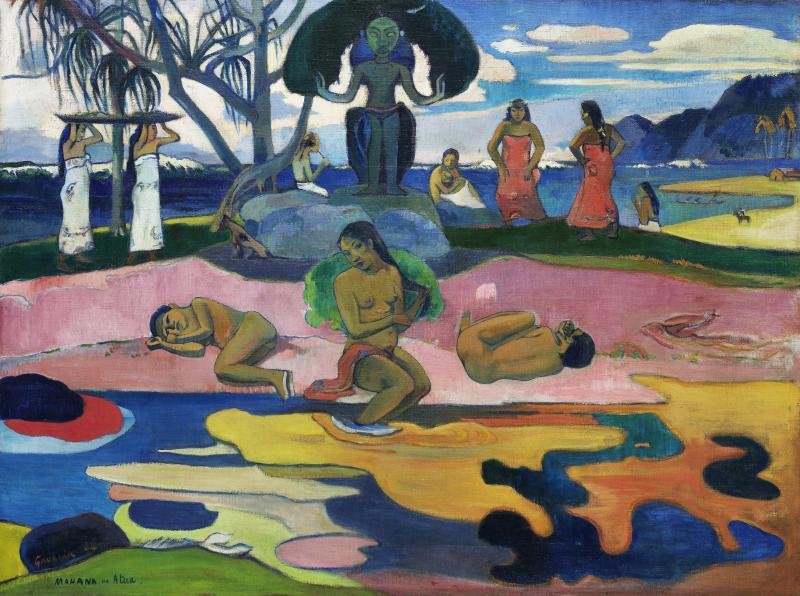Thirteen is no unlucky number here, with these movements of art still being felt today. Not to mention lining or filling a fair few museums. Ever wanted to know what movement a painting or sculpture belongs to? What characteristics to look for? Or maybe what their influences were? Well, these brief paragraphs will help you run through it all.
Want to skip ahead? Here’s our list of 13 influential art movements pre 1900s:
Renaissance
Renaissance Classicism
Renaissance Naturalism
Mannerism
Baroque
Ukiyo-e
Rococo
Neoclassicism
Romanticism
Realism
Impressionism
Neo-Impressionism
Post-Impressionism
1400-1600 Renaissance (French for rebirth)
The Renaissance movement is marked by a renewed sense in the classical ideals of Greece and Rome, for example in further studies of learning, and in their guiding values. This art period is often divided into Early Renaissance (1400-1490) in which the style was being formed, while the pinnacle of the movement is referred to as High Renaissance (1490-1530).
The artwork’s often referenced scenes from the bible, but later began to include moments from daily life; self-portraits, lovers etc.
Renaissance art is most commonly associated with Italy – this being where the movement originated and was at its height of popularity – but it soon reached the rest of Europe.
Characteristics:
- Human figures are more animated
- Greater depth from using a linear perspective
- Realistic landscape
- Classical influences
- Fine detailing
Where: Western & Northern Europe
Famous Artists & Artworks:
- Donatello (Donato di Niccolò di Betto Bardi) (b.1386-d.1466)
+ Saint George, 1414-17 ER
+ David, 1430-40 ER - Michelangelo (di Lodovico Buonarroti Simoni) (b.1475-d.1564)
+ David, 1501-04 HR
+ Sistine Chapel Ceiling, 1508-12 HR - Sandro Botticelli (Alessandro di Mariano Filipepi)(b.1445-d.1510)
+ The Birth of Venus, 1484-86 ER
+ La Primavera, 1477-82 ER - Leonardo da Vinci (b.1452-b.1519)
+ The Last Supper, 1495-98 HR
+ Mona Lisa, 1503-19 HR - Raphael (Raffaello Sanzio/Santi) (b.1483-d.1520)
+ The Sistine Madonna, 1512 HR
+ La Fornarina, 1520 HR
Key: ER = Early Renaissance, HR = High Renaissance

Sistine Chapel Ceiling, 1508-12 by Michelangelo. Image is courtesy of Calvin Craig (Unsplash)

The Birth of Venus, 1484-86 by Sandro Botticelli
Renaissance Classicism 1400s –
An intellectual movement of the Renaissance period, Renaissance Classicism – as you’ve probably guessed by the name – reflected more deeply on the classical periods of Ancient Greece and Rome, with the aim to relive it as closely as possible.
Typically, the artwork had mythological influences (the heroes of which were greatly celebrated) or looked instead to its ancient history.
Characteristics:
- Strong art principles; symmetry, proportion and balance.
- Harmony within the painting
- Greater anatomical accuracy
- Mythology
- Features classical architecture
Where: Western Europe
Famous Artists & Artworks:
- Raphael (Raffaello Sanzio/Santi) (b.1483-1520)
+ The School of Athens, 1509-11 - Masaccio (Tommaso di Giovanni di Simone Cassai) (b.1401-d.1428)
+ The Trinity, 1427-28 - Andrea Mantegna (b.1431-d.1506)
+ Saint Sebastian, 1480

School of Athens, 1509-11 by Raphael. Image is courtesy of Raymond Yee licensed under CC BY 2.0

The Trinity, 1427-28 by Masaccio. Bill Perry/Shutterstock.com
Renaissance Naturalism 1400s –
There’s a strong conveyance of mood in the Naturalism of Renaissance art. Achieving a more emotional expression, whether in conveying the emotion through the scene’s context and/or in the human form. The subjects are also given greater care and attention, and with far less artistic altering.
Characteristics:
- Light
- More natural colour tones
- Natural setting
- Subtle perspective
- Textured surfaces
Where: Western & Northern Europe.
Famous Artists & Artworks:
- Jan Van Eyck (b.1395-d.1441)
+ Arnolfini Portrait, 1434 - Albrecht Dürer (b.1471-d.1528)
+ Self-Portrait, 1500 - Hugo Van Der Goes (b.1440-d.1482)
+ The Adoration of the Kings (Monforte Altar), 1470

The Adoration of the Kings (Monforte Altar), 1470 by Hugo Van Der Goes. Image is courtesy of Jean-Louis Mazières
1520-1600 Mannerism
Considered to have been influenced by the Renaissance period, whilst rejecting its more common themes such as harmony, and instead creating images that appeared more artificial in nature. The intent of which was to show off the artist’s skills.
This is not to be confused with Northern (Antwerp) Mannerists (1500-1540) which aimed to merge Gothic and Renaissance art with; dramatic compositions, intricate and rich clothing, to bright colours.
Characteristics:
- Greater flamboyance than the Renaissance period
- Exaggerated/unusual poses
- Open to interpretation; often involving several stories in the image
- Decorative
- Sensuous
- Elongated limbs
Where: Europe
Famous Artists & Artworks:
- (Agnolo di Cosimo) Bronzino (1503-1572)
+ An Allegory of Cupid with Venus, 1545 - Giorgio Vasari (b.1511-d.1574)
+ The Garden of Gethsemane, 1570 - Parmigianino (Girolamo Francesco Maria Mazzola) (b.1503-d.1540)
+ Madonna of the Long Neck, 1535-40 - Jacopo da Pontormo (Carrucci) (b.1494-d.1557)
+ The Deposition from the Cross, 1525-28

Madonna of the Long Neck, 1535-40 by Parmigianino

The Deposition from the Cross, 1525-28 by Jacopo da Pontormo. Image is courtesy of Cea. Licensed under CC BY 2.0
1590-1700/1740 Baroque
The religion and politics of each country had a great influence on the Baroque period, in particular the Catholic Counter-Reformation, with divine imagery used to either strengthen someone’s position of power, or to appeal to the masses. However, in protestant countries, the artwork was designed for the emerging middle classes and showed greater realism e.g. 17th Century Dutch paintings.
There was also an increase in the commission of easel paintings; with themes of still-life, everyday scenes, to views of the city and countryside.
The artistry of Baroque was used to allure with dramatic imagery, and heightened emotional expressions.
Characteristics:
- Great plays with light
- Rich colours
- Theatrical
- Allegory
- Emotional
- Grandeur
- Wider subject matter
- Alluring
Where: Europe and Latin America.
Famous Artists & Artworks:
- Johannes Vermeer (b.1632-d.1675)
+ The Visit, 1657
+ The Milkmaid, 1657-58 - Rembrandt (Harmenszoon) van Rijn (b.1606-d.1669)
+ Artemesia, 1634
+ The Descent from the Cross, 1634 - Gian Lorenzo Bernini (b.1598-d.1680)
+ Apollo and Daphne, 1622-25 - Anthony van Dyck (b.1599-d.1641)
+ Lucas and Cornelis de Wael, 1627
+ Charles I with M. de St Antoine, 1633 - Diego (Rodríguez de Silva y) Velázquez (b.1599-d.1660)
+ Las Meninas, 1656 - Peter Paul Rubens (b.1577-d.1640)
+ The Descent from the Cross, 1612-1614
+ Lady Elizabeth Thimbelby and her Sister, 1637

The Milkmaid, 1657-58 by Johannes Vermeer

The Descent from the Cross, 1612-1614 by Peter Paul Rubens. Image is courtesy of Lluís Ribes Mateu
1615-1868 Ukiyo-e
Although it could be argued as a style or a classification of prints, rather than a movement, Ukiyo-e (Japanese colourful woodblock prints and paintings) was popular for hundreds of years during the Edo Period, and has influenced many movements around the world; Impressionism, Art Nouveau, Modernism and Superflat, to name just a few.
Translated, Ukiyo-e means ‘pictures of the floating world’ and though they were forms of mass-produced art, they’re still highly treasured and sought after today.
The subject matter varied from this “floating world” with courtesans, geishas, actors and theatre scenes, to nature, interiors, folklore, and moments of everyday life.
Characteristics:
- Full natural colour range, graphic in appearance
- Defined lines
- Asymmetrical and flat designs
- Common subjects; nature, actors or women
Where: Japan
Famous Artists & Artworks:
- Katsushika Hokusai (b.1760-d.1849)
+ The Great Wave, 1830-32 - (Utagawa) Andō Hiroshige (b.1797-d.1858)
+ Snowy Landscape, 1842
+ Moon and Wild Geese, 1836
+ The Plum Garden at Kameido, 1857 - Tōshūsai Sharaku (Saitō Jūrōbei) (unknown)
+ The Actors Sanogawa Ichimatsu III in the Role of the Courtesan Onayo and Ichikawa Tomiemon in the Role of Kanisaka Tōma, 1794 - Utagawa Kuniyoshi (Igusa Magosaburō) (b.1798-d.1861)
+ Mitsukuni and the Skeleton Spectre, 1843-45
20th Century styles of Japanese print-art include;
- Shin-Hanga (meaning “New Prints”) use traditional woodblock printing, with similar subjects to Ukiyo-e, but the paper is textured and has clear western influences in design.
- Sōsaku-Hanga was also influenced by western art; in that the artist should also produce the prints, where before this was delegated to staff and assistants.

The Plum Garden at Kameido, 1857 by Andō Hiroshige

The Actors Sanogawa Ichimatsu III in the Role of the Courtesan Onayo and Ichikawa Tomiemon in the Role of Kanisaka Tōma, 1794 by Tōshūsai Sharaku
1700-1760/80 Rococo
Developing from the earlier Baroque movement, Rococo is much softer in style. Emerging first within France it soon spread across Europe, especially Germany and Austria. Its colours were subtler than what had gone before, with an overall appearance of airiness, and a softer diffusion in light.
Its subjects were more to do with pleasure, especially courtship, and could be seen to be infused with a sense of playful fantasy.
Characteristics:
- Swirls and curves
- Light colouring
- Playful
- Aristocracy
- Decorative
- Asymmetrical
Where: United States, Western Europe & Russia
Famous Artists & Artworks:
- Jean-Antoine Watteau (b.1684-d.1721)
+ Pilgrimage to Cythera, 1717 - Jean-Honoré Fragonard (b.1732-d.1806)
+ The Swing, 1767 - François Boucher (b.1703-d.1770)
+ The Triumph of Venus, 1740

The Swing, 1767 by Jean-Honoré Fragonard. Image is courtesy of Lluís Ribes Mateu

The Triumph of Venus, 1740 by François Boucher
1750-1850 Neoclassicism
A return to classical thinking spurned on by the archaeology of Ancient Greece and Rome. In particular its ideals and emphasis on serious contemplation. Neoclassicism is strongly connected to the period known as Enlightenment; an intellectual movement that looked at reason, science, God and humanity. It has also come to be associated with the French Revolution.
Neoclassicism explored serious themes and turned away from the frivolousness of earlier art. Its hope was to inspire moral righteousness.
Characteristics:
- More defined compositions
- Linear designs
- Morals and values
- Common classical themes – history, heroes, myths
- Historical detailing e.g. costumes, buildings etc
Where: Europe & Russia
Famous Artists & Artworks:
- Anton Losenko (b.1737-d.1773)
+ Farewell of Hector and Andromache, 1773 - Angelica Kauffman (b.1741-d.1807)
+ Design, 1778-80
+ The Sorrow of Telemachus, 1783 - Antonio Canova (b.1757-d.1822)
+ Psyche Revived by Cupid’s Kiss, 1794 - Jacques-Louis David (b.1748-1825)
+ The Oath of the Horatii, 1784

Farewell of Hector and Andromache, 1773 by Anton Losenko

The Sorrow of Telemachus, 1783 by Angelica Kauffman
1780-1850/70 Romanticism
This movement rejected the serious and stifling attitude of Neoclassicism in favour of exploring the individual psyche; through emotions, feelings and the spiritual. Romanticism rejected the rationalisation of life.
Characteristics:
- Emphasis of nature
- Imaginative
- Fantasy
- Medieval interests
- Softer paint lines
- A sense of soul: emotions, feelings, passions
- Supernatural themes – sin, evil, devil
Where: Western Europe
Famous Artists & Artworks:
- Joseph Mallord William Turner (b.1775-d.1851)
+ Norham Castle, Sunrise, 1845 - John Constable (b.1776-d.1837)
+ Old Sarum, 1834 - William Blake (b.1757-d.1827)
+ Pity, 1795 - Henry Fuseli (b.1741-d.1841)
+ The Shepherd’s Dream, from ‘Paradise Lost’, 1793

Norham Castle, Sunrise, 1845 by Joseph Mallord William Turner

Pity, 1795 by William Blake
1840-1950 Realism (plus Photorealism & Hyperrealism)
Realism does exactly what it says on the label; looks at the world and tries to capture the reality of it, rather than aesthetic beauty or imaginative ideas.
At times Realism was considered to have a lack of morals, because it presented a world people didn’t want to acknowledge e.g. different social classes and the great difference to be had between them. Other times it was just an accurate image of nature, with no social commentary.
Characteristics:
- Recording scenes of the time without “touch-up”
- Location – widening the interior, or urban-scapes, to reveal working life and places of entertainment etc
- Detailed images of the body
Where: Western Europe, Russia & United States
Famous Artists & Artworks:
- Gustave Courbet (b.1819-d.1877)
+ After Dinner at Ornans, 1848-9
+ Dressing the Dead Girl/(Bride), 1855 - Honoré (-Victorin) Daumier (b.1808-d.1879)
+ The Third Class Carriage, 1862-64 - Jean-François Millet (b.1814-d.1875)
+ The Gleaners, 1857 - Edward Hopper (b.1882-d.1967)
+ Automat, 1927
From Realism came more modern developments:
Hyper-realism to create images that look like photos, but only so far as being a strong reference point for their accuracy, and as such are considered to have more character and emotion, especially when viewed close-up.
Meanwhile its predecessor: Photo-realism seeks to produce exact copies of a photo; enough that you could be fooled in deciding which is the original. However, both have been affected with technological advancements in the digital field, allowing for greater attention to detail.

Dressing the Dead Girl/(Bride), 1855 by Gustave Courbet

The Third Class Carriage, 1862-64 by Honoré Daumier
1860-1900 Impressionism
Originally, the term was coined by critics as a suggestion that the artwork was incomplete. However, the artists later adopted the term themselves as they moved away from traditional painting techniques to new methods that caught the essence of a moment. This was achieved through conveying sensory perceptions; light, shadow, colour and movement.
Wanting to enhance the atmosphere of the artwork by catching a passing moment, the Impressionists began to work in-situ; whether it was in nature or in city scenes.
Characteristics:
- Quick short paint strokes, often broken
- The movement of sunlight
- Bright colours
- Present-day painting
Where: Australia, Egypt, Europe, Russia, East Asia, Latin America, Canada, United States etc.
Famous Artists & Artworks:
- (Oscar) Claude Monet (b.1840-d.1926)
+ Woman with a Parasol – Madame Monet and Her Son, 1875
+ Bridge over a Pond of Water Lilies, 1899 - Pierre-Auguste Renoir (b.1841-d.1919)
+ Bal du Moulin de la Galette, 1876
+ Claude Monet with Mme Henriot, 1880
+ La Promenande au Bord de la Mer (Le Bois de la Chaise Noirmoutier), 1892 - Mary Cassatt (b.1844-d.1926)
+ Five O’Clock Tea, 1880

Woman with a Parasol – Madame Monet and Her Son, 1875 by Claude Monet

Claude Monet with Mme Henriot, 1880 by Pierre-Auguste Renoir. Image is courtesy of Carlos Rodriguez. Licensed under CC BY-ND 2.0
1884-1935 Neo-Impressionism
This is a separate group within the Impressionist movement that focused on technical application. In particular divisionism – an optical method of light and colour achieved by systematically, and individually putting primary colours directly onto the canvas. Thereby creating the optical effect of colours mixing together and as such an overall image. Up close these can present as tiny dots, while further away they give the full composition of landscapes and urban life.
This method is seen to be divided into two camps: Pointillism – application of tiny dots, and Divisionism – separation of colour and its effect; the paint being applied either as dots or in small dab-like strokes. However, it’s also been argued amongst historians whether these methods are the same and should therefore be classified under divisionism alone, rather than pointillism, a term one of the Neo-Impressionists, Paul Signac, had rejected.
Furthermore, many consider Neo-Impressionism not a movement, but a specific style of work within Post-Impressionism. See what you think.
Characteristics:
- Tiny dots or strokes
- Contrasting colours up close
- Luminosity
- Bright colours
Where: Primarily France and Belgium. Also seen in Germany, Austria, Switzerland and Italy.
Famous Artists & Artworks:
- Georges (-Pierre) Seurat (b.1859-d.1891)
+ Bathers at Asnières, 1884
+ A Sunday Afternoon on the Island of La Grande Jatte, 1884-86 - Paul Signac (b.1863-d.1935)
+ Place des Lices, Saint-Tropez, 1893
+ La Corne d’Or, Constantinople, 1907 - Maximilien Luce (b.1858-1941)
+ Morning, Interior, 1890
+ Factory in the Moonlight, 1898 - Henri-Edmond Cross (Delacroix) (b.1856-d.1910)
+ Pines Along the Shore, 1896
 Bathers at Asnières, 1884 by Georges Seurat
Bathers at Asnières, 1884 by Georges Seurat

A Sunday Afternoon on the Island of La Grande Jatte, 1884-86 by Georges Seurat

Pines Along the Shore, 1896 by Henri-Edmond Cross
1886-1910/20 Post-Impressionism
It’s hard to unite specific features of Post-Impressionism, other than they all held the desire to pull away from Impressionism’s capturing of a moment. This separation being marked differently by the four artists associated with Post-Impressionism, each of which took a unique approach.
There was Gauguin, who helped to create the movement Synthetism; a merge of subject and artistic emotions, along with flat, clear, colourful forms. Van Gogh’s highly introspective and expressive artwork, with influences from Ukiyo-e. Cezanne who created a somewhat logical and geometric approach to nature, along with producing forms through heavily applied colour. Finally, there was Seurat who helped to develop Neo-Impressionism’s use of light and contrasting colour in small dot/strokes, to reveal a complete composition (see Neo-Impressionism; pointillism).
Characteristics:
- Symbolism
- Abstraction
- Heightened artificialness
- Bright colour
- Strong use of lines
Where: Western & Northern Europe. Predominantly France.
Famous Artists & Artworks:
- Paul Cezanne (b.1839-d.1906)
+ Still Life with Quince, Apples, and Pears, 1885-87 - Vincent van Gogh (b.1853-d.1890)
+ Wheat Field with Cypresses, 1889 - Paul Gauguin (b.1848-d.1903)
+ Mahana No Atua (Day of the God), 1894
+ Where Do We Come From? What Are We? Where Are We Going? 1897-98 - Georges-Pierre Seurat (b.1859-d.1891)

Still Life with Quince, Apples, and Pears, 1885-87 Paul Cezanne

Wheat Field with Cypresses, 1889 by Vincent Van Gogh

Mahana No Atua (Day of the God), 1894 by Paul Gauguin.
And that’s the end of our list, so which of the 13 influential art movements has inspired you? Or maybe you feel with missed one, or that a movement needs a more expansive article? We’d love to hear from you, please send us a submission and share your knowledge.











